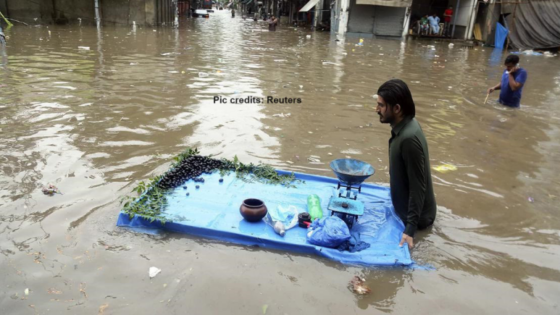Introduction:
Around 1980, India started implementing governmental plans to preserve resources and ecosystems and promote social growth. The early 2000s era witnessed the National Communication (NATCOM) study coming into action to execute climate change strategies. The evaluation acknowledged its susceptibility to warming temperatures and emphasised the demand for resilience. India has accomplished tremendous achievements when developing and implementing environmental strategies, with environmental organisations formed at multiple tiers.
During the Climate Conference 2007 at Bali, emerging economies committed to Nationally Appropriate Mitigation Action (NAMA). Observing the same, India launched its National Action Plan on Climate Change (NAPCC) in 2008.
Climate Action Tracker (CAT) evaluates India’s existing strategies and actions as “insufficient” not relation to its full commitment. The “Insufficient” assessment implies that India’s environmental measures and initiatives in 2030 require substantial enhancements to be compatible with its 1.5°C warming goals. If nations worldwide adopted India’s strategy, temperatures would rise past 2°C and perhaps surpass 3°C. Delhi requires global support to execute every single measure required for 1.5°C compliance. The CAT anticipated that India’s emissions would be 4.0-4.3 GtCO2e by 2030 assuming the existing policy. This projection is more modest, owing to a relative fall in conventional power output and a decline of various energy-related CO2 emissions through manufacturing and transit.
Body:
Several significant energy-related proposals and norms came to light in 2023, such as the National Green Hydrogen Mission, the National Electricity Plan 2023, and the freshly revised Energy Conservation Act. These regulations and policies serve a significant part in determining the power sector. Delhi has yet to agree on cutting away coal-generated electricity or transitioning to a fossil-free future. Its most recent power programme involves an extra 25.5GW of coal output throughout the latter part of the decade, in addition to its 25.6GW existing proposed output.
Introductory Part:
The CAT repeatedly stressed that natural gas does not qualify as bridge energy, and India’s present LNG growth may jeopardise the 1.5 degrees Celsius goal. To meet the 1.5°C target, emissions from fossil fuels must be transitioned out of India’s power sector by 2040. In 2023, India experienced an exceptionally hot summer, resulting in unpredictable power consumption. Considering a nine per cent rise in power consumption between April to October, progress remained uneven. Previously predicted to reach a maximum of 230 GW, the season’s high in June touched roughly 220 GW and subsequently decreased to 209 GW throughout July, owing to a warmer summer, particularly in India’s northern regions. Yet, consumption soared, hitting 240 GW in October, exceeding the record of 201 GW in 2022. Electricity usage increased by sixteen per cent during August and September of 2023, against the same time in 2022. Inadequate monsoon precipitation limited the supply of hydropower, growing more dependence on fossil fuel-based electricity, causing unprecedented national coal output and a spike in imports.
Descriptive Part:
During the G20 declaration under India’s presidency, global leaders pledged to triple green energy output by 2030 and reaffirmed their aspiration to achieve carbon neutrality before 2050. Although an additional renewable objective represents a significant move, the G20 has been chastised for failing to establish targets for cutting away conventional energy sources. Given its status as a worldwide advocate of the green cause, India remains hesitant about dedicating itself to phasing away coal. The country’s stance at COP26 which opposed a coal phase-out was reiterated within the G20 assertion, which highlighted the “phasedown” of unrestrained coal, although the word “phasedown” signifies an ambiguous aim that fails to identify the scope or timeline.
Under G20, India squandered a chance to press for an international energy source transition-out pledge as a weight for additional funding and regional cooperation at COP28 by not explicitly declaring its willingness to slowly phase out coal. Setting a timetable for cutting out fossil fuels might provide significant impetus for COP28 including the worldwide inventories. The G20’s climate action pledge is not sufficient, emphasising the requirement for significant pledges to be made at the future COP29.
In 2022, the Indian government revised its Energy Conservation Act, paving the way for a prospective indigenous carbon trade. The Amendment Act provides mechanisms for the creation of an emissions trading system via the adoption of a ‘Carbon Credit Trading Scheme’ (CCTS). The Bureau of Energy Efficiency (BEE), in partnership with the Ministries of Forests, Power, Environment and Climate Change, was appointed and tasked with developing the Indian Carbon Exchange. The proposed architecture for the planned emissions trading scheme’s governing body is now being consulted on by stakeholders. The prototype carbon sector, which would inevitably comprise petroleum products, steel and iron manufacturing, concrete, and paper and pulp products, is predicted to start being active in 2025.
Numerous sector-specific efforts in Glasgow have been initiated to expedite tackling climate change. At best, such actions might eliminate the 2030 pollution imbalance by roughly 9%, or 2.2 GtCO2e, but determining which is novel and what has been addressed by current NDC commitments is difficult. Participants pledged to reduce greenhouse gases in every sector by thirty per cent internationally during the following decade. The fossil fuel exit strategy aims to phase out the unrestrained coal fire through the 2030s or 2040s and also to stop developing additional coal-powered power plants. Participants who signed the 100% EVs statement declared that EV transport ought to be responsible for 100% of all fresh automobile and wagon registrations in 2040, with 2035 being the target year for the biggest economies. Governments decided “to put an end to deforestation and soil deterioration by 2030” in terms of trees. The Beyond Oil & Gas Alliance (BOGA) aims to help promote a controlled gradual elimination of the extraction of oil and gas. If such industrial activities have yet to be included in current NDC objectives, they must be included. As with any aim, implementing the relevant policies and actions is crucial to ensure specific particular objectives are met.
Delhi serves the top few major methane polluters, besides the Russians and Chinese who are not a member of the Global Methane Commitment. Worldwide, the power industry must take the initiative in emission abatement by 2030, phasing out the use of fossil fuels in the future. India’s goals for growing its coal sector are incompatible with that endeavour. India accepted the complete EV assertion, focusing on one and three-wheeler automobiles. The nation’s leadership is currently collaborating on measures to make all motorcycles electrified by 2026, significantly earlier compared to the COP26 deadline.
Participants who signed the 100% EVs statement declared that EV transport ought to be responsible for 100% of all fresh automobile and wagon registrations in 2040, with 2035 being the target year for the biggest economies. Governments decided “to put an end to deforestation and soil deterioration by 2030” in terms of trees. The Beyond Oil & Gas Alliance (BOGA) aims to help promote a controlled gradual elimination of the extraction of oil and gas. If such industrial activities have yet to be included in current NDC objectives, they must be included. As with any aim, implementing the relevant policies and actions is crucial to ensure specific particular objectives are met.
The majority of such foreign coal-based thermal energy facilities were closed owing to elevated global prices for coal as well as inadequate power purchase deals to cover rising production expenses. As global warming keeps influencing the climate throughout the Indian subcontinent, a strong power industry demand-satisfaction strategy utilises analytical information. This must be built on a shift to clean energy to satisfy high demand, aided by storage facilities. In the lack of infrastructure assistance for moving heavy usage to alternative energies, coal will continue to be used to meet summertime consumption.
India boasts the globe’s second-largest manufacturer of coal behind the Chinese mainland, although it remains an importer by default owing to its high consumption. The administration is currently pursuing initiatives to increase local output in hopes that it may become an international supplier of thermal energy within a few years. Coal is regarded notably an essential part of the nation’s energy strategy due to its local availability, as opposed to natural gas and oil, that the country does not generate in substantial quantities. As stated by the Indian Coal Minister, India has set a course to transition from being a net buyer to a net seller of heating coal until 2026, mostly to neighbours such as Nepal, Bhutan, Bangladesh, and Sri Lanka.
India routinely incentivises traditional fuels and clean energy sources in the manner of individual aid, tax rebates, price controls, and additional government support, although net benefits for conventional energies are at least nine times greater than those offered for alternatives. Although mining expenditures remain virtually stable throughout 2017, these continue to be around 35% greater than green grants. Coal India Ltd, the planet’s oldest publicly traded fossil fuels manufacturer, obtains a two-billion-dollar US subsidy yearly. Delhi is contemplating CCUS as a potential environmentally friendly approach to accomplish significant carbon reduction across hard-to-abate fields while allowing the government to maintain using its coal reserves. Yet, Delhi has stated in its LT-LEDS that CCUS was never a feasible technological choice for upgrading current steam energy plants since it’s not economically feasible in Delhi. Delhi is searching for longer-term LNG agreements. Petronet LNG Ltd., the nation’s biggest gas buyer, wants lengthy agreements to acquire an extra twelve million metric tonnes of LNG, which accounts for 60% of its present imports. Energy authorities are additionally pushing for gas pipeline construction to capitalise on fluctuations in prices. It is worth noting that the nation has no significant petroleum resources. The federal government has implemented substantial measures to encourage the planned export boom by expanding LNG port facilities and re-gasification ability, as well as enhancing the infra to allow LNG shipping.
Conclusion:
The Indian government adopted a complex strategy to promote photovoltaic component production. To expand the supply of locally made solar modules, government officials authorised a two billion dollar production-linked incentive (PLI) plan in the year 2022, having the goal of attracting an additional USD 11 billion from individuals. Yet, the solar cell production industry has significant hurdles because of excessive dependence on foreign downstream supplies, making it hard to remain affordable.
To boost consumer interest in locally made solar cells, the authorities doubled the GST for green energy technology and levied a 40% import tariff on international photovoltaic cells including 25% for photovoltaic cells. Yet, because of a lack of local supplies, authorities are additionally contemplating lowering the tariff charge.
The upcoming National Budget offers regulations over 4 GWh of battery backup via the Viability Gap Funding (VGF), which aims to encourage power production initiatives that are rational but tumble within the range of commercial sustainability and are currently being authorised by the government. However, this is insufficient to satisfy the nation’s long-term energy storage demand envisaged according to the newly established national power plan.
References:
-
BEE. (2018). PAT scheme (Perform, Achieve and Trade scheme). https://www.youtube.com/watch?v=ye4RpHAqwDk
-
BEE. (2021). ECBC Residential | Bureau of Energy Efficiency. https://beeindia.gov.in/content/ecbc-residential
-
BEE. (2023). Agriculture DSM | Bureau of Energy Efficiency, Government of India, Ministry of Power. https://beeindia.gov.in/en/programmesdemand-side-management/agriculture-dsm
-
Bhardwaj, N. (2021, July 15). Electric Vehicle Industry in India: Investment Outlook and Market Profile. India Briefing. https://www.india-briefing.com/news/electric-vehicle-industry-in-india-why-foreign-investors-should-pay-attention-21872.html/
-
Bloomberg. (2022). Indian Railways Reports Slow Progress in Installing Renewable Energy . https://www.bloomberg.com/news/articles/2022-11-23/indian-railways-reports-slow-progress-in-installing-clean-energy#xj4y7vzkg
-
Bloomberg. (2023). India Rushes to Long-Term LNG Deals to Speed Shift From Coal . https://www.bloomberg.com/news/articles/2023-02-07/india-plans-rush-of-long-term-lng-deals-to-speed-shift-from-coal#xj4y7vzkg
-
Buckley, T., & Shah, K. (2018). IEEFA update: India coal plant cancellations are coming faster than expected. In IEEFA. http://ieefa.org/india-coal-plant-cancellations-are-coming-faster-than-expected/
-
Business Standard. (2022). New policy to cut green hydrogen cost by 40-50%, says Indian Oil | Business Standard News. https://www.business-standard.com/article/companies/new-policy-to-cut-green-hydrogen-cost-by-40-50-says-indian-oil-122022000220_1.html
-
Business Standard News. (2021, September 14). India moving away from coal slowly, considerable progress by states: Study. https://www.business-standard.com/article/economy-policy/india-moving-away-from-coal-slowly-considerable-progress-by-states-study-121091400307_1.html
-
Business Standard News. (2022). States to meet 25% of their energy needs from renewable energy sources. https://www.business-standard.com/article/economy-policy/states-to-purchase-25-of-their-energy-needs-from-renewable-energy-122072300162_1.html
-
Business Today. (2019). Govt notifies FAME-II scheme with Rs 10,000-crore outlay to encourage adoption of electric vehicles. https://www.businesstoday.in/current/economy-politics/govt-notifies-fame-ii-scheme-with-rs-10000-crore-outlay-to-encourage-adoption-of-electric-vehicles/story/326068.html
-
CEA. (2019). All India Installed Capacity. https://cea.nic.in/wp-content/uploads/2020/02/installed_capacity-05-2.pdf
-
CEA. (2023). All India Installed Capacity of Power Stations (MW) – March 2023. https://cea.nic.in/wp-content/uploads/installed/2023/03/IC_March_2023.pdf
-
Chakravarty, S., & Somanathan, E. (2021). There is no economic case for new coal plants in India. World Development Perspectives, 24, 100373. https://doi.org/10.1016/J.WDP.2021.100373
-
Chaliawala, N. (2021, June 25). Govt extends the deadline of EV promotion scheme FAME-II as only a fraction of targets achieved so far. The Economic Times. https://economictimes.indiatimes.com/industry/renewables/govt-extends-the-deadline-of-ev-promotion-scheme-fame-ii-as-only-a-fraction-of-targets-achieved-so-far/articleshow/83843086.cms
-
Clean Energy Ministerial. (2019). EV30@30 campaign | Clean Energy Ministerial. http://www.cleanenergyministerial.org/campaign-clean-energy-ministerial/ev3030-campaign
-
Climate Action Tracker. (2020). Paris Agreement Compatible Sectoral Benchmarks: Elaborating the decarbonisation roadmap. Climate Analytics, NewClimate Institute. https://climateactiontracker.org/publications/paris-agreement-benchmarks/
-
Climate Action Tracker. (2022a). Warming projections global update: Massive gas expansion risks overtaking positive climate policies. Climate Analytics, NewClimate Institute. https://climateactiontracker.org/publications/massive-gas-expansion-risks-overtaking-positive-climate-policies/
-
Climate Action Tracker. (2022b). Natural gas in India: A pathway towards reducing India’s dependency on gas. Climate Analytics, NewClimate Institute https://climateactiontracker.org/publications/natural-gas-in-india-a-pathway-towards-reducing-indias-dependency-on-gas/
-
Climate Action Tracker. (2023a). Clean electricity within a generation: Paris-aligned benchmarks for the power sector. Climate Analytics, NewClimate Institute. https://climateactiontracker.org/documents/1159/CAT_2023-09-19_Briefing_ParisBenchmarks_PowerSector.pdf
-
Climate Action Tracker. (2023b). Countdown to COP28: time for world to focus on oil and gas phase-out, renewables target, not distractions like CCS. Climate Analytics, NewClimate Institute. https://climateactiontracker.org/publications/countdown-to-COP28/
-
Climate Analytics. (2021). 1.5°C national pathway explorer — India. https://1p5ndc-pathways.climateanalytics.org/countries/india/
-
Climate Analytics. (2023). G20 renewables target is no substitute for a clear fossil fuel phase out. https://climateanalytics.org/blog/2023/g20-renewables-target-is-no-substitute-for-a-clear-fossil-fuel-phase-out/
-
CNBCTV18. (2022). India’S Forest Cover Increased In 2019-21, But That May Not Be Good News; Here’S Why. https://www.cnbctv18.com/environment/indias-forest-cover-increased-in-2019-21-but-that-may-not-be-good-news-heres-why-12163712.htm
-
CTR. (2022). Climate Transperancy Report- India. https://www.climate-transparency.org/wp-content/uploads/2022/10/CT2022-India-Web.pdf
-
Davidson, C. (2023). How India and the G20 ducked the coal question again. Devex. https://www.devex.com/news/how-india-and-the-g20-ducked-the-coal-question-again-106245
-
Department of Fertilizers. (2022). Neem Coated Urea. https://www.fert.nic.in/node/2193
-
DieselNet. (2021). Emission Standards: India: Heavy-Duty Truck and Bus Engines. https://dieselnet.com/standards/in/hd.php
-
Down To Earth. (2023). MoEFCC refuses to put new forest conservation rules on hold, says do not dilute forest rights act. https://www.downtoearth.org.in/news/governance/moefcc-refuses-to-put-new-forest-conservation-rules-on-hold-says-do-not-dilute-forest-rights-act-86932
-
DownToEarth. (2023). India, Japan to improve bilateral cooperation towards clean energy transition. https://www.downtoearth.org.in/news/renewable-energy/india-japan-to-improve-bilateral-cooperation-towards-clean-energy-transition-88029
-
ET Auto. (2023). Hydrogen-based Mobility Ecosystem: With government and corporate support India gets ready for hydrogen-based transportation ecosystem. https://auto.economictimes.indiatimes.com/news/auto-technology/with-government-and-corporate-support-india-gets-ready-for-hydrogen-based-mobility-ecosystem/98382148
-
ET EnergyWorld. (2022a). India, US announce launch of new energy storage task force to support clean energy transition. https://energy.economictimes.indiatimes.com/amp/news/power/india-us-announce-launch-of-new-energy-storage-task-force-to-support-clean-energy-transition/94715433
-
ET EnergyWorld. (2022b). Is India ready for the switch to Green Hydrogen in passenger trains? https://energy.economictimes.indiatimes.com/news/renewable/is-india-ready-for-the-switch-to-green-hydrogen-in-passenger-trains/96535240
-
ET EnergyWorld. (2023). Budget 2023: Battery energy storage system of 4,000 MWH to be set up. https://energy.economictimes.indiatimes.com/news/power/budget-2023-battery-energy-storage-system-of-4000-mwh-to-be-set-up/97520821
-
ETEnergyWorld. (2023a). EXPLAINER: What is the Forest (Conservation) Amendment Bill, 2023 and why it matters. https://energy.economictimes.indiatimes.com/news/renewable/explainer-what-is-the-forest-conservation-amendment-bill-2023-and-why-it-matters/102238129
-
ETEnergyWorld. (2023b). India’s power consumption grows nearly 8 pc to 847 billion units in first half of FY24. https://energy.economictimes.indiatimes.com/news/power/indias-power-consumption-grows-nearly-8-pc-to-847-billion-units-in-first-half-of-fy24/104270522
-
ETEnergyWorld. (2023c). Thermal power stations’ coal consumption surges in September 2023: A growing reliance on coal? https://energy.economictimes.indiatimes.com/news/coal/thermal-power-stations-coal-consumption-surges-in-september-2023-a-growing-reliance-on-coal/104637837
-
European Investment Bank. (2023). India: EIB backs green hydrogen deployment and joins India Hydrogen Alliance. https://www.eib.org/en/press/all/2023-045-eib-backs-green-hydrogen-deployment-in-india-and-joins-india-hydrogen-alliance
-
G20. (2023). G20 New Delhi Leaders’ Declaration. https://www.g20.org/content/dam/gtwenty/gtwenty_new/document/G20-New-Delhi-Leaders-Declaration.pdf
-
Garg, A. (2022). Vehicle Scrappage policy to be applicable from April 1, all you need to know. Auto News | Zee News. https://zeenews.india.com/auto/vehicle-scrappage-policy-to-be-applicable-from-april-1-all-you-need-to-know-2449657.html
-
Garg, V., Viswanathan, B., Narayanaswamy, D., Beaton, C., Ganesan, K., Sharma, S., & Bridle, R. (2020). Mapping India’s Energy Subsidies 2020: Fossil fuels, renewables, and electric vehicles. IISD. https://www.iisd.org/publications/report/mapping-indias-energy-subsidies-2020-fossil-fuels-renewables-and-electric
-
Global Energy Monitor. (2022a). Global Infrastructure Tracker – January 2022. https://docs.google.com/spreadsheets/d/1NbEpGt2K5nY0XTSB_vlOyw9Ug8ZmvvOaRPuO9TgISIw/edit#gid=0
-
Global Energy Monitor. (2022b). Global Coal Terminal Capacity by Country (Mtpa) – December 2022. https://docs.google.com/spreadsheets/d/1CeehRR2QQCk_Rqp9ApriJQ5ra4K59fU8blQqTzzJVgs/edit#gid=0
-
Global Energy Monitor. (2023a). Global Coal Project Finance Tracker. https://globalenergymonitor.org/projects/global-coal-project-finance-tracker/
-
Global Energy Monitor. (2023b). New Coal-fired Power Capacity in India by Year (MW) (January 2023). https://docs.google.com/spreadsheets/d/1hbnTKLn1NJxVFsbyfvpzkbYKwvbxY-EbLvc-b5N0kiM/edit#gid=557672932








Leave a Reply
You must belogged in to post a comment.